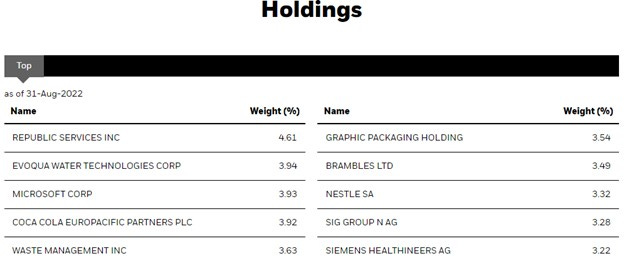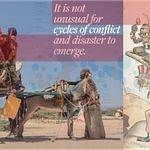Hello Interactors,
This is the first of a series of posts where I wrangle, disentangle, and find an angle on an alternative sustainable economy. My starting point is circular economy. It’s a seemingly straight forward concept — reduce, reuse, recycle, and repair. If only it was that easy.
As interactors, you’re special individuals self-selected to be a part of an evolutionary journey. You’re also members of an attentive community so I welcome your participation.
Please leave your comments below or email me directly.
Now let’s go…
ESG DISHARMONY
It’s been a confusing week for the green economy. The world’s largest asset manager, BlackRock, was the source of some of the biggest news. BlackRock has made strides in recent years to be a world leader in environmental, social, and corporate governance, or as it’s commonly called – ESG. ESG is a framework of metrics companies pledge to follow intended to identify, assess, and manage environmentally and socially sustainable, but still profitable, risks and opportunities through investments, corporate culture, and practices. This can typically, or ultimately, lead to divestments in the fossil fuel industry as more and more investors, customers, and employees desire and demand reductions in CO2 emissions.
But the state of Louisiana isn’t having it. They announced this week they’re pulling $749 million from BlackRock funds. Their state treasurer said BlackRock has “blatantly anti-fossil fuel policies” that damage the state’s energy industry and thus state revenue. It’s not just fossil-fuel fans who are unhappy with ESG. Elon Musk famously quipped that ESG’s are “an outrageous sham.” Tesla was initially praised for their leadership on the environment, “E”, but were removed from the S&P500 ESG index because of their lackluster reputation for “S” and “G”. Last April a judge and jury found Tesla to be liable for promoting a racially hostile environment at Tesla's factory in Fremont, California.
Dust ups like these have caused many companies, investors, and independent ESG rating firms to soften their language, add or subtract certain metrics, change the parameters, or rebrand their rating schemes. As a result, ESG, a segment of worldwide investment accounting for 1/3 of total assets worth around $35 trillion, has become extremely murky. In July, The Economist wrote,
“As it is, measurement of the size of the ESG market is confusing, the ratings are too subjective, and the industry over-promises and under-delivers.”1
They went on to cite research that found
“ESG rating agencies are the veritable acme of inconsistency. A study of six of them found that they used 709 different metrics across 64 categories. Only ten categories were common to all—and they do not include such basics as greenhouse-gas emissions.”
In September, Dilbert predictably joined in the chorus of criticism.

Sadly, the concept of a ‘circular economy’ is following a similar path. Circular economies take limited raw materials used to make goods and loops them back into the economy instead of throwing them away – reduce, reuse, recycle, and repair. But the term ‘circular economy’, like ESG, has also become diffuse and trendy. The occurrence of these two words together, ‘circular economy’, doesn’t show up in the books Google has scanned until around 1990. It grew steadily until a dip leading up to the financial crisis in 2008. But since 2014, it has skyrocketed.

Even Wall Street now has funds popping up branded ‘Circular Economy’. In 2019 BlackRock launched a fund called “BlackRock Global Funds Circular Economy”. Its top holdings include two waste management companies, a Coca-Cola subsidiary, a water filtration company, and…wait for it…Microsoft? I guess that’s because of their public commitment to negative CO2 emissions. Not sure. If so, I’m suspicious of their noble, and needed, effort. Having watched the over-produced press announcement in person, I left feeling it was one part a greenwashing PR stunt and one part Microsoft seeing dollars signs selling cloud services to companies running toward their own vague, but earnest, ESG goals.
For example, running complicated AI models in the cloud to determine emission reductions, simulating breakthrough renewable energy technologies, or simply using Microsoft Teams so companies can cut their travel budgets while reducing CO2 emissions. In other words, to hit ESG goals – or attempt a circular economy – requires new technology; new technologies need software; and increasingly that software is run on Microsoft servers in the cloud…or in local data centers. Going green yields greenbacks.

Two other companies on that BlackRock list also give me pause. Both Republic Services and Waste Management profit from collecting, processing, and recycling industrial and consumer waste. More waste equals more money. One of the basic principles of sustainable and environmentally conscious business practices is reducing consumption and thus waste.
Are these companies ok with their customers cutting back on their garbage? Probably not. But they, like Microsoft, see opportunity in building ‘green’ processing plants, creating a market for recycled materials, and then reaping the profits. All of which would welcome – possibly even encourage – even more consumption. And that would yield more resource extraction and more garbage to process – resulting in more profits. That doesn’t sound very sustainable or ‘green’, unless you’re a chief financial officer.
MIND THE GAPS OF MIND TRAPS
In a 2021 paper titled Critique of the Circular Economy three researchers in the field of industrial ecology offer a critical look at the current state of the theories and practices of circular economies. Industrial ecologists track the physical resource flows of industrial and consumer systems at different spatial scales. They aim to reduce environmental impacts while enabling human well-being through more circular flows of resources instead of the more traditional linear flow of extract, produce, and dump. They write,
“In seeking to maintain a growth-based economy, critics argue, the circular economy ‘tinkers with the current modus operandi’ of “consumerism, extractivism and (liberal) capitalism, while bearing the unrealistic expectation that the individual consumer will be able to mobilize largescale change. The circular economy is considered to encourage a reboot for capitalism that requires no radical change to institutions, infrastructures, and markets.”2
In this regard, they conclude,
“Without this transition, the new economy will simply maintain the current status quo.”
These researchers, writing in the Journal of Industrial Ecology, believe,
“Circular economy is based on an ideological agenda dominated by technical and economic accounts, which brings uncertain contributions to sustainability and depoliticizes sustainable growth. Bringing together these critiques demonstrates that the circular economy is far from being as promising as its advocates claim it to be.”
This begs the question, what do advocates promise? In 2020, another group of researchers writing in the journal, Resources, Conservation & Recycling write,
“While there were only 116 academic articles published on the topic [of circular economy] from 2001 to 2008, this number has grown exponentially to over 4900. Nevertheless, most of the [circular economy] discourse has actually been developed by actors in the government and private sectors, which have specific political and economic agendas, and have often used the [circular economy] as a narrative device for greenwashing.”3
In their paper they seek to identify research gaps while also developing a classification scheme for the different beliefs and approaches to describing and articulating circular economies. In doing so, they hope to avoid the disillusion the ESG movement is witnessing by identifying shared beliefs, approaches, and missteps and their deficiencies.
In the set of research papers they evaluated, these five gaps were identified:4
1. Systemic thinking on entropy, growth, capitalism, and decoupling
They found no coherent systemic economic or social theory underlying the circular economy. This makes for fertile ground to establish one, but it also leads to fuzzy thinking, confusion, disarray, and skepticism. There is seemingly no agreement on the physics of entropy given laws of thermodynamics. Materials degrade over time through recycling processes which means they can’t be recycled indefinitely. There is no ‘perpetual recycling machine’. New raw materials must then be extracted and injected into recycled materials to boost their value.
They note the ‘biggest elephant in the room’ is how to decouple growth and capitalism from the circular economy. Capitalism only works with growthism. Because the circular economy is a degrowth strategy, is it incompatible with capitalism or does the idea of capitalism need to adapt to the limits of earth’s resources?
2. The materials, energy, and biodiversity [interconnections]
The promise of the circular economy is to recover materials which requires less energy, find nature-based solutions that contribute to increased biodiversity, and thus reduce the overall demand on raw materials while bettering our ecosystem and quality of life. This is the essence of the metaphorical circle in a circular economy. However, we still need material and energy to build a renewable energy infrastructure. Waste incinerators, as one example, keeps garbage out of the earth while generating energy but at a cost to air quality.
An abundance of energy is also needed to run all the recycling and processing plants intended to feed reused materials back into the economy. In addition, when done at scale, a circular economy could become so efficient that it encourages more pollution, energy demand, and renewable resources. Increased energy production, say through biofuels, could lead to further biodiversity loss, which is needed to improve soil health, reduce erosion, and improve air and water quality. Raw materials, energy, and biodiversity are interconnected and can’t be addressed in isolation or in a linear flow on the path toward a circular economy.
3. Evaluating and assessing the full impacts of a circular economy
We’re not always as clever as we think, so we need ways to evaluate, assess, and adjust as we go. This is especially true given a common misnomer that increased efficiencies lead to reductions in resource consumption. Imagine all the inventions throughout history that promised more leisure time at home when in fact they often led to more to more production and consumption. For example, laundry machines led to more laundry.

This is known as the Jevons paradox. Increased efficiencies lead to falling costs which increases demand leading to more consumption. Circular economies that promote eco-efficiency run the risk of creating rebound effects. That’s the paradox. Attempts to slow down and reduce leads to the opposite — accelerated extraction, consumption, and destruction. Cost reductions from cheap renewable energy, for example, could increase demand for it. Meanwhile, that cheap energy may allow a cheaper widget to be made increasing demand and consumption of the widget. Humans need self-regulating evaluative safeguards on our ingenuity if we want us, and our circular economy, to thrive and survive.
YOU CAN’T FLEE ESG
4. Governance, social justice, and cultural change
A 2017 study looked at 114 different definitions of circular economy and only 18-20% considered social equity. Looking at nearly 5000 academic papers, researchers found just 804 from the fields of social sciences and humanities.5 Most were from environmental science, engineering, and energy sciences. Yet, as researchers found in 2018, those attempting to put the circular economy into practice identified the main barrier to adoption is cultural acceptance and changes to consumer beliefs and behaviors. Technology was the least of their concerns.
They concluded that “circular economy is a niche discussion among sustainable development professionals.”6 There’s also the issue of power. In the race toward energy and economic transition, once again dominant states will forcibly instill technocratic top-down governmental and corporate agendas. Meanwhile, historically marginalized stakeholders will continue fighting for social, environmental, and economic justice. Sounds like ESG won’t be going away any time soon…or ever.
5. Alternative visions of circularity
The lack of attention on cultural and social dimensions could be addressed by including likeminded visions and existing practice. The concept of circularity and ecological reciprocity is fundamental to Indigenous cultures around the world. Many have extended, modified, and adapted sustainable ancestral hunter-gatherer, agrarian, and pastoral ways of living — and some still do. They also tend to adopt pluralistic ideals that enable and foster mutual coexistence and largely avoid ethnocentric economic and environmental agendas. And they don’t seek global dominance of resources and cultural assimilation.
For centuries Buddhism, Confucianism, and Taoism have also promoted harmonious societies complete with ecologically sound philosophies and practices. Some of those philosophies are alive today. Since 2000 Japan has adopted a “Fundamental Plan for Establishing a Sound Material-Cycle Society” which tracks
“how effectively materials are used in industrial activities and people’s daily lives, in terms of creating more wealth using fewer resources.”
There are many alternative ways to reduce, reuse, recycle, and repair that all include elements of circularity, reduced consumption, and measures of growth. And it’s likely our diverse planet will need more than one flavor of circular economy.
These five gaps illustrate both the diversity and complexity surrounding conceptions and implementations of the circular economy. The Economist magazine highlighted how the subjectivity and size of ESG not only leads to confusion but a tendency to over-promise and under-deliver. It seems the circular economy suffers the same risk. And yet, human history shows examples of how plurality of thought, belief, and culture when coupled with eco-efficient circularity and reciprocity fueled centuries of coexistence with each other and the planet’s complex web of nested systems.
Circularity is not new, and it’s not a trend. Examples are found at all levels of ecologies, and societies, on which we depend. Understanding, situating, and articulating past and existing circular concepts in nature and societies – representing diverse interpretations from all corners of the world – is what is needed to enable a socially just, economically sound, and environmentally sustainable path forward.
ESG is an attempt to lead us there under the current economic model. And while the ‘E’ in emissions should be the key to ESG, we need all three for the circular economy.
Tune in next time as I unpack the history of modern articulations of a circular economy. I’ll map socio-economic, environmental, and political approaches against a range of technological utopias and dystopias.
ESG should be boiled down to one simple measure: emissions. The Economist. 2022.
Critiques of the circular economy. Hervé Corvellec, Alison F. Stowell, Nils Johansson. Journal of Industrial Ecology. 2022.
A typology of circular economy discourses: Navigating the diverse visions of a contested paradigm. Martin Calisto Friant, Walter J.V. Vermeulen, Roberta Salomone. 2020.
Ibid
(3)
Barriers to the Circular Economy: Evidence From the European Union (EU). Julian Kirchherr, Laura Piscicelli, Ruben Bour, Erica Kostense-Smit, Jennifer Muller, Anne Huibrechts-Truijens, Marko Hekkert. Ecological Economics. 2018.
















ESG and the Circular Economy